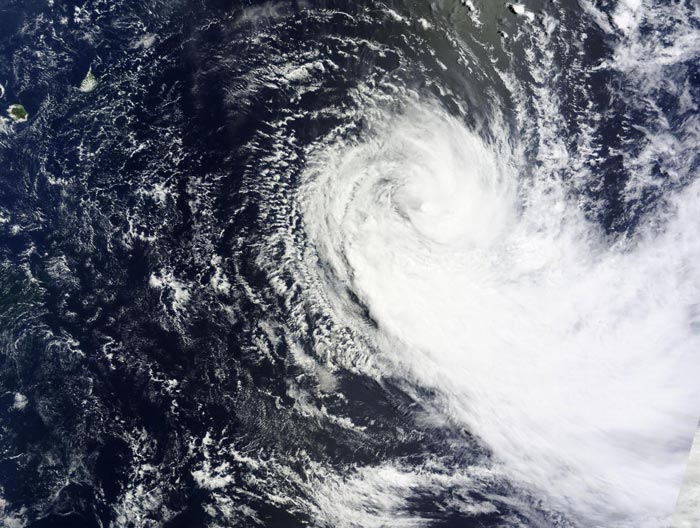NASA's Terra satellite sees Tropical Cyclone Glenda stretching out

NASA's Terra satellite captured a visible image of Glenda on Feb. 27 that revealed the bulk of storm's clouds pushed southeast of the center. Credit: NASA Goddard MODIS Rapid Response Team
When Terra passed over the Southern Indian Ocean on Feb. 27, the Moderate Resolution Imaging Spectroradiometer (MODIS) instrument captured a visible image of the storm.
In the image, the bulk of clouds associated with the storm appeared to be pushed southeast of the center and away from the islands of Mauritius and La Reunion.
The Joint Typhoon Warning Center (JTWC) noted today, Feb. 27, “animated multispectral satellite imagery shows the system has begun to show signs of elongation as the main convective bands are displaced eastward of a partially-exposed low-level circulation center.”
At 0900 UTC (4 a.m. EST), Glenda's maximum sustained winds had dropped to near 45 knots (51.7 mph/83.3 kph). Glenda was centered near 22.4 south latitude and 67.2 east longitude, about 573 nautical miles (659.4 miles/1,061 km) east-southeast of Port Louis, Mauritius. Glenda was moving to the south at 7 knots (8 mph/12.9 kph).
JTWC reported in their upper-level atmosphere analysis that Glenda is located in a “marginal environment with moderate vertical wind shear offset by excellent poleward outflow.”
By Saturday, Feb. 28, Glenda is expected to transition to an extra-tropical storm and become a cold-core system.
Media Contact
All latest news from the category: Earth Sciences
Earth Sciences (also referred to as Geosciences), which deals with basic issues surrounding our planet, plays a vital role in the area of energy and raw materials supply.
Earth Sciences comprises subjects such as geology, geography, geological informatics, paleontology, mineralogy, petrography, crystallography, geophysics, geodesy, glaciology, cartography, photogrammetry, meteorology and seismology, early-warning systems, earthquake research and polar research.
Newest articles

Sea slugs inspire highly stretchable biomedical sensor
USC Viterbi School of Engineering researcher Hangbo Zhao presents findings on highly stretchable and customizable microneedles for application in fields including neuroscience, tissue engineering, and wearable bioelectronics. The revolution in…

Twisting and binding matter waves with photons in a cavity
Precisely measuring the energy states of individual atoms has been a historical challenge for physicists due to atomic recoil. When an atom interacts with a photon, the atom “recoils” in…

Nanotubes, nanoparticles, and antibodies detect tiny amounts of fentanyl
New sensor is six orders of magnitude more sensitive than the next best thing. A research team at Pitt led by Alexander Star, a chemistry professor in the Kenneth P. Dietrich…





















